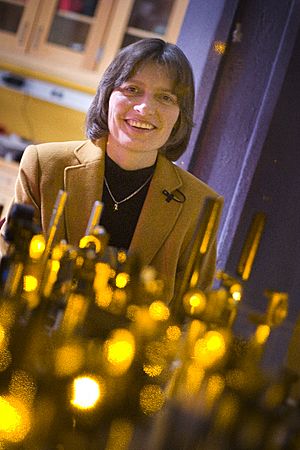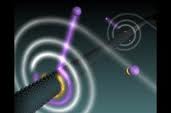Lene Hau facts for kids
Quick facts for kids
Lene Hau
|
|
|---|---|

Lene Hau in her laboratory at Harvard, 2007
|
|
| Born | November 13, 1959 Vejle, Denmark
|
| Nationality | Danish |
| Alma mater | Aarhus University |
| Known for | Slow light, Bose–Einstein condensates, nanotechnology, quantum optics |
| Awards | Ole Rømer Medal George Ledlie Prize MacArthur Fellowship Rigmor and Carl Holst-Knudsen Award for Scientific Research |
| Scientific career | |
| Fields | Physics and Nanotechnology |
| Institutions | Harvard University Rowland Institute for Science |
| Doctoral students | Naomi Ginsberg, Christopher Slowe, Zachary Dutton |
Lene Vestergaard Hau (born November 13, 1959) is a Danish physicist and teacher. She is a professor of physics at Harvard University.
In 1999, she led a team at Harvard University that achieved something amazing. They used a special state of matter called a Bose–Einstein condensate to slow down a beam of light. They made it move as slow as about 17 meters per second (about 38 miles per hour)! Then, in 2001, her team was able to stop a light beam completely.
Later, their work helped them transfer light into matter, and then back from matter into light. This is very important for new technologies like quantum encryption (super-safe secret codes) and quantum computing (super-fast computers). More recently, she has studied how tiny, super-cold atoms interact with extremely small systems, known as nanoscale systems.
Besides her research, Professor Hau teaches physics and applied physics at Harvard. She has also taught about energy science, covering topics like photovoltaic cells (solar panels), nuclear power, batteries, and photosynthesis. She often speaks at international conferences and helps shape science policies for different organizations. In 2002, Discover Magazine named her one of the 50 most important women in science.
Contents
Early Life and Education
Lene Hau was born in Vejle, Denmark. She earned her first degree in mathematics in 1984 from the University of Aarhus in Denmark. Two years later, she received her master's degree in physics from the same university.
For her advanced studies, Lene Hau focused on quantum theory. She worked on ideas similar to how fiber optic cables carry light. But her research involved tiny strings of atoms in a silicon crystal that carry electrons. During her studies, she spent seven months at CERN, a famous science lab in Switzerland. She received her doctorate degree in 1991.
A Career in Physics
In 1991, Lene Hau joined the Rowland Institute for Science in Cambridge, Massachusetts. There, she started exploring the possibilities of slow light and cold atoms. In 1999, she became a postdoctoral fellow at Harvard University. Even though she was trained in theoretical physics (working with ideas and math), she became very interested in experimental research. She wanted to create a new form of matter called a Bose–Einstein condensate.
At first, she was told it would be too hard for a theorist to do such experiments. But she didn't give up! She found other ways to get funding and became one of the first physicists to create this special condensate. In September 1999, she was appointed a professor at Harvard. She also received tenure, which means she has a permanent teaching position.
In 2001, she made history by being the first person to completely stop light. She used a Bose–Einstein condensate to achieve this amazing feat. Since then, she has done a lot of research in areas like electromagnetically induced transparency and different parts of quantum physics. Her work has also helped develop new quantum devices and tiny nanoscale applications.
Controlling Light and Matter
Lene Hau and her team at Harvard University have shown incredible control over light and matter. One of their most exciting experiments involved two Bose–Einstein condensates. In 2006, they successfully transferred a qubit (a basic unit of quantum information) from light to a matter wave, and then back into light. This experiment was described in the journal Nature in 2007.
This experiment uses the idea that, in quantum mechanics, atoms can act like waves as well as particles. This allows atoms to do surprising things, like passing through two openings at once. In a Bose–Einstein condensate, a light pulse can be squeezed by 50 million times without losing any of its information. This information, which is in the light pulse, can then be transferred to the atom waves. Because all the atoms move together, the information doesn't get lost.
The light makes some of the cloud's 1.8 million sodium atoms enter special "quantum superposition" states. This means they are in two places at once. One part stays still, and another part travels between two clouds. A second laser then writes the shape of the light pulse into the atom waves. When this control laser is turned off, the light pulse disappears, but a "matter copy" of the information remains.
Before this, scientists couldn't easily control optical information as it traveled. This experiment by Hau and her team was the first time they successfully controlled coherent optical information. A physicist named Irina Novikova called it "a beautiful demonstration." She noted that before this, light storage was measured in milliseconds, but now it was "fractional seconds," which is a "really dramatic time."
Lene Hau explained the potential of this work: "While the matter is traveling between the two Bose–Einstein condensates, we can trap it, possibly for minutes, and change it in any way we want." This new way of controlling quantum information could be used in developing quantum computers and quantum cryptography.
Cold Atoms and Nanoscale Systems
In 2009, Lene Hau and her team used lasers to cool clouds of one million rubidium atoms. They got them to just a tiny fraction of a degree above absolute zero (the coldest possible temperature). Then, they launched this tiny atomic cloud towards a carbon nanotube, which was charged with hundreds of volts. The results of this experiment were published in 2010. They showed new ways that cold atoms and extremely small nanoscale systems can interact.
They saw that most atoms passed by the nanotube. But about 10 out of every million atoms were strongly attracted to it. This caused them to speed up a lot and get much hotter. At this point, the fast-moving atoms split into an electron and an ion. These two parts rotated together around the nanowire, completing each orbit in just a few trillionths of a second. The electron then got pulled into the nanotube through a process called quantum tunneling. This made its partner ion shoot away at a speed of about 26 kilometers per second (about 59,000 miles per hour)!
In this experiment, atoms could quickly break apart without even hitting each other. The team pointed out that this effect is not caused by gravity, like in black holes in space. Instead, it's caused by the strong electrical charge in the nanotube. This experiment combines nanotechnology with cold atoms. It shows a new type of super-sensitive detector that could help us understand matter waves even better. Scientists also believe this setup could lead to many new studies of single atoms.
Awards and Recognition
Lene Hau has received many awards for her important work:
- 1986-1989: Research Fellowship from the Faculty of Sciences, University of Aarhus, Denmark.
- 1988: Carlsberg Scholarship from the Carlsberg Foundation, Denmark.
- 1991: Became a Principal Investigator for the Atom Cooling Group at the Rowland Institute.
- 2000: Year 2000 Award from the Top Danmark Foundation, Copenhagen.
- 2001: Samuel Friedman Rescue Award from the Samuel Friedman Foundation.
- 2001: Honorary degree, Æreshåndværker Kjøbenhavns Håndværkerforening, in the presence of Her Majesty Queen Margrethe II of Denmark.
- 2001: The Ole Rømer Medal from the Danish Natural Science Research Council.
- 2001: NKT Award from Danish Physical Society.
- 2001-2006: MacArthur Fellow (also known as a Genius Grant).
- 2004: Richtmyer Memorial Award from the American Association of Physics Teachers.
- 2008: George Ledlie Prize.
- 2008: Rigmor and Carl Holst-Knudsen Award for Scientific Research.
- 2010: Named "Årets Verdensdansker" (World Dane of the year) by the Global Network of Danes Worldwide. This was because she "emphatically and persistently has put Denmark on the world map."
- 2011: Carlsberg Foundation's Research Award from the Royal Danish Academy of Sciences and Letters.
Honorary Positions and Memberships
Lene Hau holds several honorary positions and is a member of important scientific groups:
- Royal Danish Academy of Sciences and Letters - honorary appointment.
- 2008: Royal Swedish Academy of Sciences - foreign member.
- 2009: American Academy of Arts and Sciences - member.
- 2009: American Association for the Advancement of Science (AAAS) - fellow.
- 2010: United States Department of Defense - National Security Science and Engineering Faculty Fellow.
- 2011: Aarhus Universitet - honorary alum.
See also
 In Spanish: Lene Hau para niños
In Spanish: Lene Hau para niños


